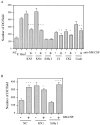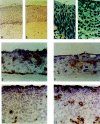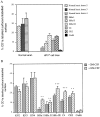Colonization of in vitro-formed cervical human papillomavirus- associated (pre)neoplastic lesions with dendritic cells: role of granulocyte/macrophage colony-stimulating factor
- PMID: 10079255
- PMCID: PMC1866413
- DOI: 10.1016/S0002-9440(10)65324-2
Colonization of in vitro-formed cervical human papillomavirus- associated (pre)neoplastic lesions with dendritic cells: role of granulocyte/macrophage colony-stimulating factor
Abstract
The purpose of this study was to investigate the ability of CD1a+ Langerhans/dendritic cells (LCs/DCs) to infiltrate human papillomavirus (HPV)-associated (pre)neoplastic lesions of the uterine cervix. Migration of LCs/DCs in the presence of keratinocytes derived from normal cervix and HPV-transformed cell lines was evaluated in Boyden chambers and in organotypic cultures and correlated with granulocyte/macrophage colony-stimulating factor (GM-CSF) production by the cells, as determined by ELISA. Conditioned media of HPV-transformed keratinocytes contained lower amounts of GM-CSF and induced a decreased motile response of LCs/DCs in the Boyden chamber assay compared with those of normal cervical keratinocytes. The migration of LCs/DCs in the presence of conditioned media from normal keratinocytes could be blocked by an anti-GM-CSF antibody, and the migration of LCs/DCs in the presence of conditioned media from HPV-transformed keratinocytes could be increased by supplementing the media with recombinant GM-CSF. GM-CSF was also a potent factor in enhancing the colonization of LCs/DCs into organotypic cultures of HPV-transformed keratinocytes, as the infiltration of LCs/DCs in the in vitro-formed (pre)neoplastic epithelium was minimal under basal conditions and dramatically increased after the addition of GM-CSF to the cultures. These results suggest that GM-CSF could play an important role in the recruitment of LCs/DCs into the HPV-transformed (pre)neoplastic cervical epithelium and be useful as a new immunotherapeutic approach for cervical (pre)cancers.
Figures





Similar articles
-
Delivery of granulocyte-macrophage colony-stimulating factor in bioadhesive hydrogel stimulates migration of dendritic cells in models of human papillomavirus-associated (pre)neoplastic epithelial lesions.Antimicrob Agents Chemother. 2004 Nov;48(11):4342-8. doi: 10.1128/AAC.48.11.4342-4348.2004. Antimicrob Agents Chemother. 2004. PMID: 15504863 Free PMC article.
-
Defensins induce the recruitment of dendritic cells in cervical human papillomavirus-associated (pre)neoplastic lesions formed in vitro and transplanted in vivo.FASEB J. 2007 Sep;21(11):2765-75. doi: 10.1096/fj.06-7646com. Epub 2007 Apr 30. FASEB J. 2007. PMID: 17470569
-
E-cadherin-dependent adhesion of dendritic and Langerhans cells to keratinocytes is defective in cervical human papillomavirus-associated (pre)neoplastic lesions.J Pathol. 2005 Jul;206(3):346-55. doi: 10.1002/path.1771. J Pathol. 2005. PMID: 15852499
-
The association of cervicovaginal Langerhans cells with clearance of human papillomavirus.Front Immunol. 2022 Oct 12;13:918190. doi: 10.3389/fimmu.2022.918190. eCollection 2022. Front Immunol. 2022. PMID: 36311788 Free PMC article. Review.
-
Immunological role of dendritic cells in cervical cancer.Adv Exp Med Biol. 2007;601:155-62. doi: 10.1007/978-0-387-72005-0_16. Adv Exp Med Biol. 2007. PMID: 17713002 Review.
Cited by
-
An epithelial organoid model with Langerhans cells for assessing virus-host interactions.Philos Trans R Soc Lond B Biol Sci. 2019 May 27;374(1773):20180288. doi: 10.1098/rstb.2018.0288. Philos Trans R Soc Lond B Biol Sci. 2019. PMID: 30955491 Free PMC article.
-
MIP3 alpha stimulates the migration of Langerhans cells in models of human papillomavirus (HPV)-associated (pre)neoplastic epithelium.Cancer Immunol Immunother. 2007 Jul;56(7):1087-96. doi: 10.1007/s00262-006-0255-2. Epub 2006 Dec 5. Cancer Immunol Immunother. 2007. PMID: 17146629 Free PMC article.
-
Candidate Soluble Immune Mediators in Young Women with High-Risk Human Papillomavirus Infection: High Expression of Chemokines Promoting Angiogenesis and Cell Proliferation.PLoS One. 2016 Mar 18;11(3):e0151851. doi: 10.1371/journal.pone.0151851. eCollection 2016. PLoS One. 2016. PMID: 26990868 Free PMC article.
-
The Interaction Between Human Papillomaviruses and the Stromal Microenvironment.Prog Mol Biol Transl Sci. 2016;144:169-238. doi: 10.1016/bs.pmbts.2016.09.003. Epub 2016 Oct 11. Prog Mol Biol Transl Sci. 2016. PMID: 27865458 Free PMC article. Review.
-
HPV and Other Microbiota; Who's Good and Who's Bad: Effects of the Microbial Environment on the Development of Cervical Cancer-A Non-Systematic Review.Cells. 2021 Mar 23;10(3):714. doi: 10.3390/cells10030714. Cells. 2021. PMID: 33807087 Free PMC article. Review.
References
-
- Parkin D, Läärä E, Muir CS: Estimates of the worldwide frequency of sixteen major cancers in 1980. Int J Cancer 1988, 41:184-197 - PubMed
-
- Bosch FX, Manos MM, Munoz N, Sherman M, Jansen AM, Peto J: Prevalence of human papillomavirus in cervical cancer: a worldwide perspective. International Biological Study on Cervical Cancer (IBSCC) Study Group. J Natl Cancer Inst 1995, 87:796-802 - PubMed
-
- Cox MF, Meanwell CA, Maitland NJ, Blackledge G, Scully C, Jordan JA: Human papillomavirus type 16 homologous DNA in normal human ectocervix. Lancet 1986, ii:157-158 - PubMed
-
- Al-Saleh W, Giannini SL, Jacobs N, Moutschen M, Doyen J, Boniver J, Delvenne P: Correlation of T helper secretory differentiation and types of antigen-presenting cells in squamous intraepithelial lesions of the uterine cervix. J Pathol 1998, 184:283-290 - PubMed

